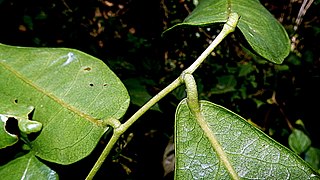
Cassia is a genus of flowering plants in the legume family, Fabaceae, and the subfamily Caesalpinioideae. Species are known commonly as cassias. Cassia is also the English common name of some species in the genus Cinnamomum of the family Lauraceae. Species of the genera Senna and Chamaecrista were previously included in Cassia. Cassia now generally includes the largest species of the legume subtribe Cassiinae, usually mid-sized trees.

Senna spectabilis is a plant species of the legume family (Fabaceae) in the subfamily Caesalpinioideae native to South and Central America. They are often grown as an ornamental in front yards, parks, gardens, buildings etc. due to their bright yellow flowers that bloom during the summer months. They are also known as golden wonder tree, American cassia, popcorn tree, Cassia excelsa, golden shower tree or Archibald's cassia.

Senna obtusifolia, known by the common names Chinese senna, American sicklepod, sicklepod, etc., is a plant in the genus Senna, sometimes separated in the monotypic genus Diallobus. It grows wild in North, Central, and South America, Asia, Africa, and Oceania, and is considered a particularly serious weed in many places. It has a long-standing history of confusion with Senna tora and that taxon in many sources actually refers to the present species.

Senna tora is a plant species in the family Fabaceae and the subfamily Caesalpinioideae. Its name is derived from its Sinhala name tora (තෝර). It grows wild in most of the tropics and is considered a weed in many places. Its native range is in Central America. Its most common English name is sickle senna or sickle wild sensitive-plant. Other common names include sickle pod, tora, coffee pod and foetid cassia. It is often confused with Chinese senna or sicklepod, Senna obtusifolia.

Senna, the sennas, is a large genus of flowering plants in the legume family. This diverse genus is native throughout the tropics, with a small number of species in temperate regions. The number of species is estimated to be from about 260 to 350. The type species for the genus is Senna alexandrina. About 50 species of Senna are known in cultivation.

Senna covesii is a perennial subshrub in the family Fabaceae, native to the Mojave Desert and Sonoran Desert in southeastern California, southern Nevada, and Arizona in the United States, and northern Baja California in Mexico. It is found on desert plains and in sandy washes between 500 and 600 m above sea level, and is very common in Joshua Tree National Park. The specific epithet honors ornithologist Elliott Coues.
Cassia falcata may refer to:

Senna alexandrina is an ornamental plant in the genus Senna. It is used in herbalism. It grows natively in upper Egypt, especially in the Nubian region, and near Khartoum (Sudan), where it is cultivated commercially. It is also grown elsewhere, notably in India and Somalia.

Albizia inundata is a perennial tree native to South America. Common names include maloxo, muqum, paloflojo, timbo blanco, timbo-ata, and also "canafistula" though this usually refers Cassia fistula.

Senna artemisioides, the wormwood senna, is a species of flowering plant in the pea family Fabaceae. It is endemic to Australia, where it is found in all mainland states and territories. Other common names include silver senna, silver cassia or feathery cassia - although "cassia" generally refers to the largest-growing Cassiinae. Some of its distinct subspecies also have common names of their own.
Cassia aldabrensis is a species of plant in the family Fabaceae endemic to Assumption and Aldabra near the Seychelles. It is threatened by habitat destruction.

Poecilanthe is a genus of flowering plants in the family Fabaceae.

Senna bicapsularis is a species of the legume genus Senna, native to northern South America, from Panama south to Venezuela and Colombia, and also the West Indies. Common names include rambling senna, winter cassia, Christmas bush, money bush, and yellow candlewood. In Florida, Senna pendula is usually cultivated as, and misapplied to, S. bicapsularis.
Senna wislizeni, commonly called Wislizenus' senna or shrubby senna. Formerly in the "wastebin taxon" Cassia sensu lato, it is now placed in the genus Senna or sometimes separated in Palmerocassia together with Senna unijuga.

Senna auriculata is a leguminous tree in the subfamily Caesalpinioideae. It is commonly known by its local names matura tea tree, avaram or ranawara, or the English version avaram senna. It is the State flower of Telangana. It occurs in the dry regions of India and Sri Lanka. It is common along the sea coast and the dry zone in Sri Lanka.

Spermacoce or false buttonweed is a genus of flowering plants in the family Rubiaceae. It comprises about 275 species found throughout the tropics and subtropics. Its highest diversity is found in the Americas, followed by Africa, Australia and Asia.

Senna occidentalis is a pantropical plant species.

Senna siamea, also known as Siamese cassia, kassod tree, cassod tree and cassia tree, is a legume in the subfamily Caesalpinioideae. It is native to South and Southeast Asia, although its exact origin is unknown.

Oxalis debilis, the large-flowered pink-sorrel or pink woodsorrel, is a perennial plant and herb in the family Oxalidaceae. Its original distribution is South America but has become a very cosmopolitan species, occurring in all continents except Antarctica. It can be found in both temperate and tropical areas.

















